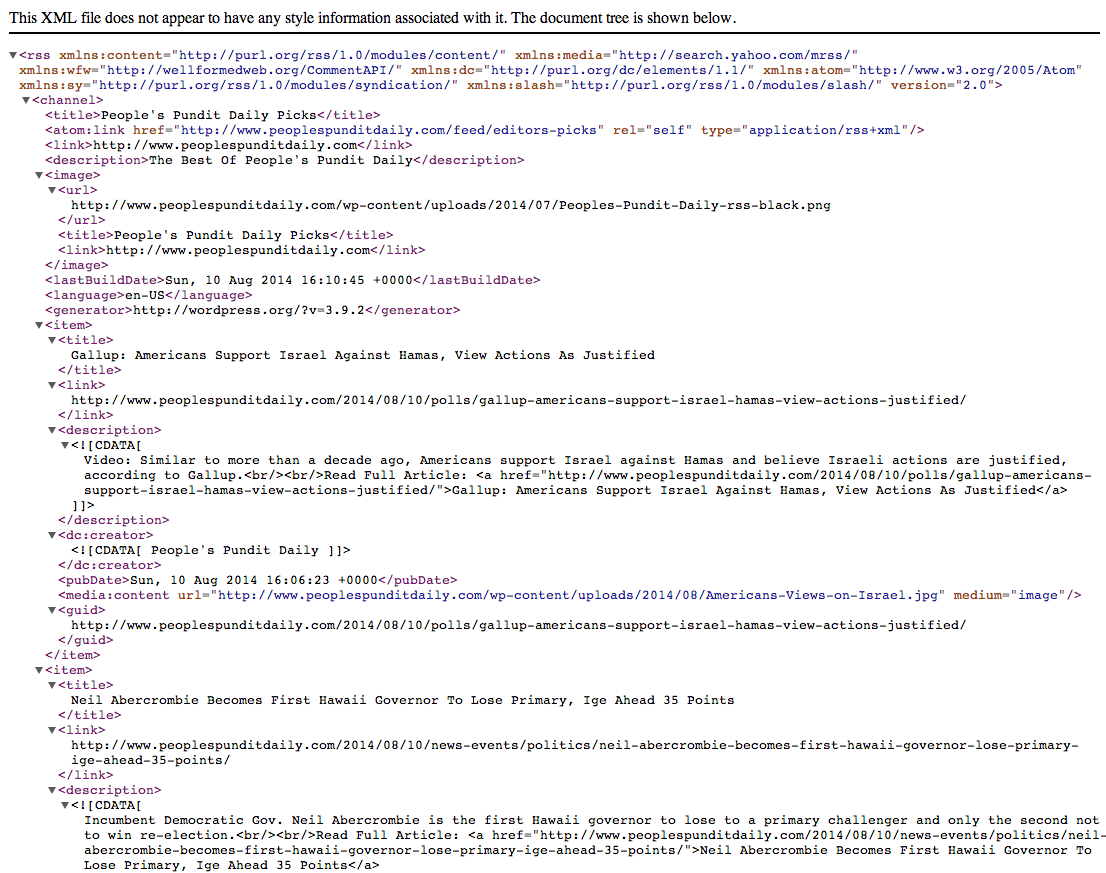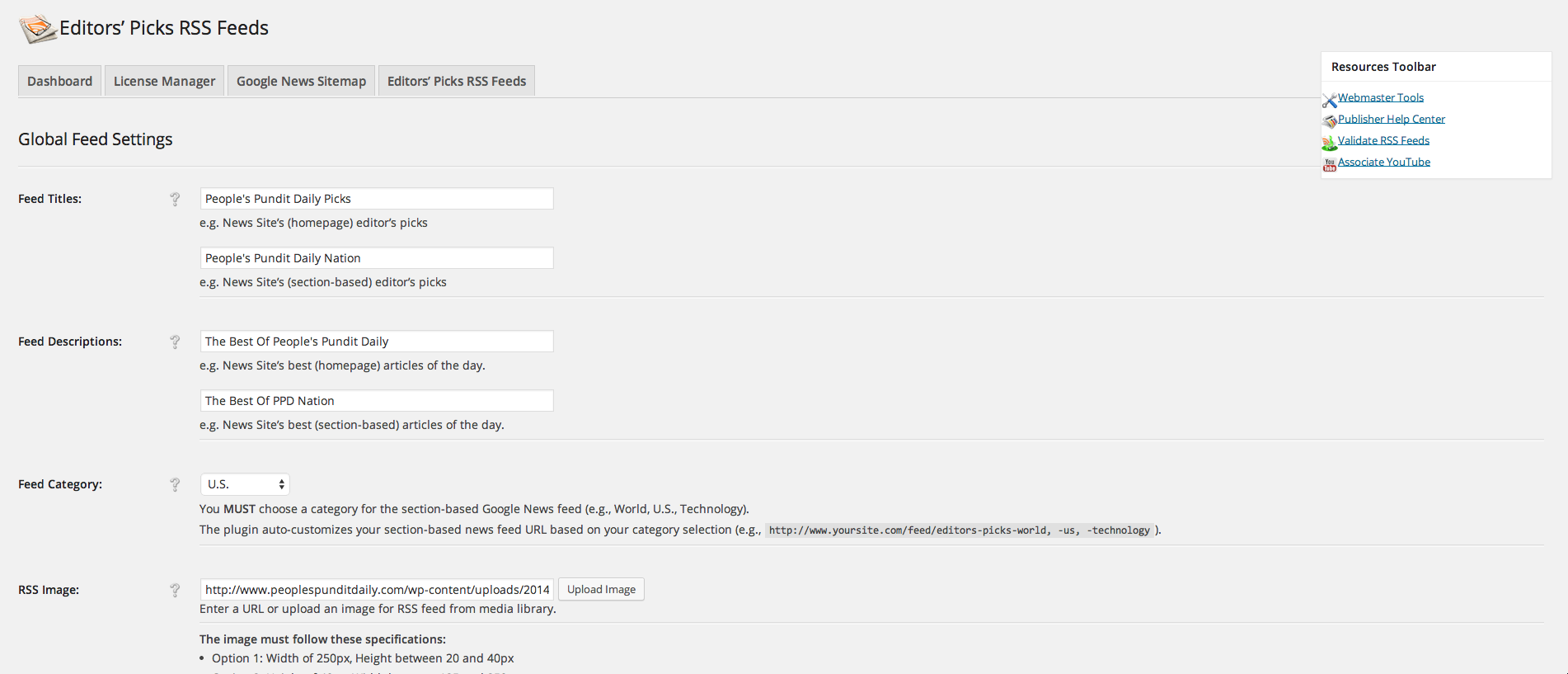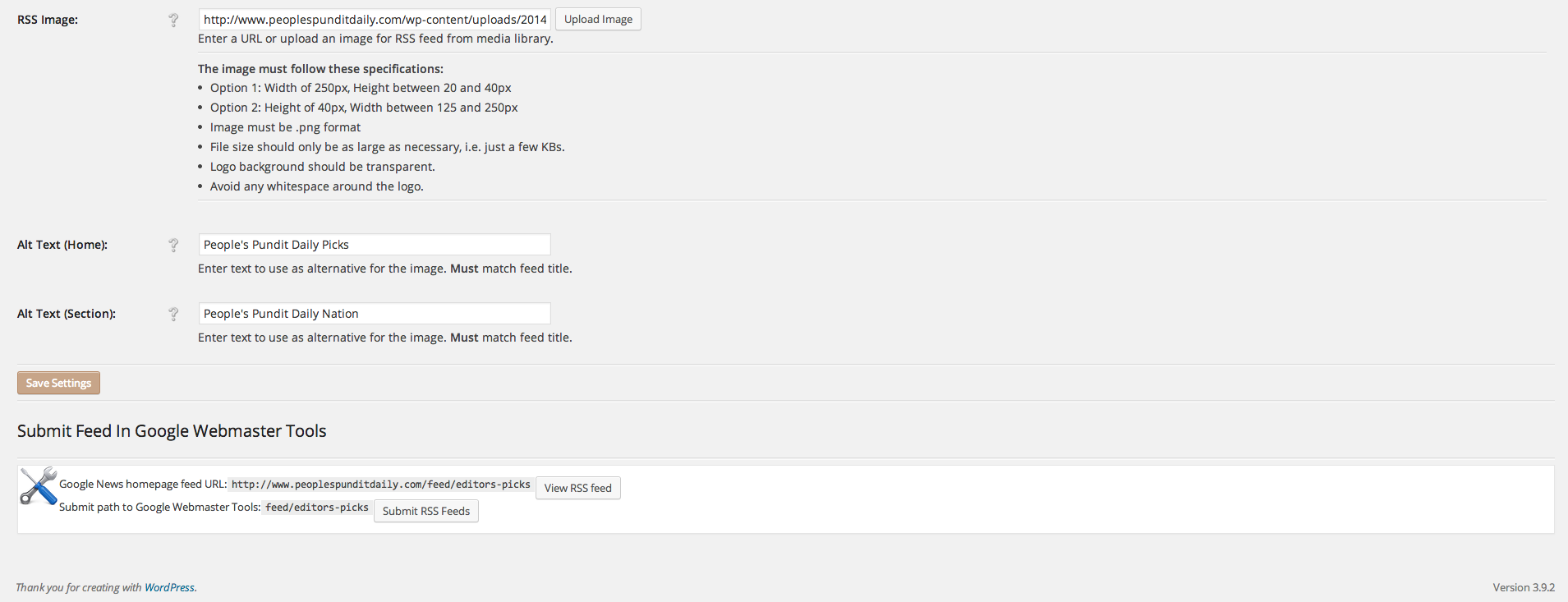 Creating custom Google News Editors’ Picks RSS Feeds with the WordPress Premium Google News Plugin is both easy and a must for any news publisher.
Creating custom Google News Editors’ Picks RSS Feeds with the WordPress Premium Google News Plugin is both easy and a must for any news publisher.
Editors’ Picks allows you, as a publisher, to provide up to five links to original news content that represent your organization’s best journalistic work, which Google will potentially feature on Google News. In this tutorial, we will walk you through creating custom Google News Editors’ Picks RSS feeds using our plugin.
With some of the more commonly used methods, there are multiple disadvantages to publishers when creating custom Google News Editors’ Picks RSS feeds. First and foremost, there is little ability to create and customize the feeds and their features. For instance, in order to meet Google’s guidelines, your feed must have a dimension-specific image included in the header, which can be accomplished by a simple function in WordPress core files. Anytime you update your version of WordPress your changes are lost, thus it is always frowned upon to edit core files.
But, even still, you are hostage to the standard WordPress feed generator, which isn’t at all conducive to taking advantage of Editors’ Picks features. You can customize feed titles, their descriptions, etc., just not with the most current solutions.
Second, because the feeds can potentially be featured on both the Google News homepage and a section-based page, we designed the WordPress Premium Google News Plugin to create one for each. Seems logical, doesn’t it? However, most other plugins and methods lack this ability, let alone the ability to completely customize their features. There is more, but we will discuss them in the tutorial as we go along.
If you, the publisher, wish to participate in Editors’ Picks, then you will first need to create and subsequently submit your custom RSS feed. We will get into submitting the feed in a bit, but let’s get into creating the feed once you have installed and activated the WordPress Premium Google News Plugin. Below is an image of the plugin’s admin page used to create and customize the feed, as well as settings and options.
Notice the screen is cut off, which is because the number of features is numerous and we have to take them one step at a time. Also notice the “Resources Toolbar” in the top-right area of the screen shot. This provides numerous tools, including Webmaster Tools, Publisher Help Center, Feed Validator and YouTube Association. This will be at your disposal at all times on all admin screens.
Feed Title
The first step is to settle on a “Feed Title” for both feeds and enter them into the text area (i.e. People’s Pundit Daily Picks & People’s Pundit Daily Nation).
The first feed title represents the homepage feed and the second the section-based, which you might want to base on one of Google’s actual topics. We used “Nation” because our section-based feed is populated with Editors’ Picks articles relating only to U.S. news, i.e. politics, policy, etc.
Please note: It is imperative that the feed titles match the alt text fields used for the image! If they do not, then you will not be able to validate the feed and Google will reject your submission.
We will get into this more in a minute, but for now, trust me you’ll get it.
Feed Description
Let’s move on to the “Feed Description” for both homepage and section-based feeds. For the feed description, just go ahead and get creative. There are no restrictions as in the case of the title and alt image. Obviously, you want them to make sense in some related fashion, but as Google News publishers, you are more than creative and capable. Take a look at the image example above and take a crack at it, then enter them into the text fields.
Feed Category
The “Feed Category” (e.g., World, U.S., Technology) pertains only to the section-based feed and determines the feed URL based upon your selection (e.g., http://www.yoursite.com/feed/editors-picks-world, -us, -technology). You MUST choose a category for the section-based Google News Editors’ Picks RSS feed before you proceed. The aforementioned URL is eventually the path you will use to submit the feed(s) to both Webmaster Tools and Google, but let’s get to more of that now.
Feed Image
Because of the design of the Google News platform that features the Editors’ Picks RSS feeds, publishers should only want to include their news site’s logo for both feeds for obvious branding purposes. This is true despite which feed is created and featured on Google News, and the reason why we didn’t design the WordPress Premium Google News plugin with the option of adding a separate image. You simply use the upload image button to either grab an image from the Media Library or grab a new one from your computer.
Please Note: You must use an image that is compliant with the image dimension guidelines provided by Google.
When we look at the finished feed at the end of the tutorial, you’ll completely understand. They are listed below the field on the admin page for your convenience, so use them. Go ahead and upload the file. The URL for the image will be added to the head section of each feed, along with the customized titles and descriptions.
Alt Text
Enter the alt text used for the image for both the homepage and section-based feeds.
Remember: It is imperative that the feed titles match the alt text fields used for the image! If they do not, then you will not be able to validate the feed and Google will reject your submission.
Finally, click the “Save Settings” button.
Validate Feeds
Before we move on to validating the feeds, please note the “Submit Feed In Google Webmaster Tools” post box below the “Save Settings” button in the image above (not below). This will be one of the most handy of the plugin’s features for you, but for now, we are only going to go ahead and check if the homepage feed was created by clicking the “View RSS Feed” button.
If no feed appears, which will give you a 404 error, then go to “Permalinks” under “Settings” in the left-hand side WP column, and click “Save Settings” to generate your custom RSS feeds. Return to the Editors’ Picks admin page and once again click on the “View RSS Feed” button. You will now see a feed like the one below.

WordPress Premium Google News Plugin also includes a Google News Editors’ Picks RSS Feed Generator that creates not one but two custom Editors’ Picks Feeds to feature your top stories.
Now, we have to validate the feed and submit it to Google News. Remember the “Resources Toolbar” on the upper right-hand side of the screen? We will follow that link, which will bring you to the very same feed validator Google reviewers will use when they check your feeds.
Enter the feed URL provided both above and in the “Submit Feed In Google Webmasters Tools” post box. If you followed the directions, then there will be no problem.
Submit Feeds
You can submit at most one feed for each section and one homepage feed. We suggest you submit just the homepage feed first, as Google reviewers are pretty fast with Editors’ Picks, and it will allow you to work anything out they may raise with you. When you know you have it right, then you can go ahead and submit the section-based feed.
If you have anymore questions, visit the Support page or email ppd.ventures.llc@gmail.com. We hope this helped you set up your feeds using the WordPress Premium Google News Plugin. If you don’t have the plugin yet, then what are you waiting for?




Do you know how much time takes to appears after google aproves the feed?
It can actually depend on the time of year sometimes. They start to get really slow in the Fall for some reason, and really really slow during the Holidays. When did they approve it?
[…] PLEASE READ TUTORIAL: Creating Custom Google News Editors’ Picks RSS Feeds With WordPress Premium Google News Plugin […]
[…] From: googlenewsplugin.com […]
I would like to see some real-life examples of these feeds. Do you have any links to sites that have this feature?
Hi DustyJoy, if I understand your question correctly, the answer is that they don’t go on other sites, they go on Google News. They are for the “Editors’ Picks” platform Google News uses to feature articles, like seen in the link below. Soon, but not yet, we will release an update that will output a widget that does just that on other WordPress sites, or creates a Javascript code for non-WP sites. But that won’t go out as an update, but rather an “Google News Feed Network” add-on.
http://googlenewsplugin.com/2014/10/14/wordpress-google-news-plugin-version-1-5-now-available/
Thank you for your response, Richard D. Baris. So if we want a Google News Feed, for example in our case specifically about lung cancer, this is not the product for us…is that correct? Is there a Google News plug in for us to feed relevant news items onto our new WordPress site? Thanks again!
Yup, you’re correct. This one –> https://wordpress.org/plugins/google-news-automatic-widget/ https://wordpress.org/plugins/google-news-links/ https://wordpress.org/plugins/google-news/ <– which I know a lot of people seem to like. Hope that helps!
Let me try that again. Again, you’re correct. This plugin won’t help you with what you need to do. This one –> https://wordpress.org/plugins/google-news-automatic-widget/ https://wordpress.org/plugins/google-news-links/ https://wordpress.org/plugins/google-news/ <– which I know a lot of people seem to like. Hope that helps!
Thank you, Richard!
No problem, anytime!
How long after paying will I get the link to the plugin? I paid with PayPal earlier and still have not seen the email. Not in my spam/junk folder either. Thanks.
You should definitely have received it already. I think the EDD software is giving me a problem. I will resend it now.
Hi,
I made a category in my WP news site & just wanted to use that as Editor Pick’ RSS Feed. How can I using your plugin ?
Looking forward for reply
Thanks
Hi Scott, sorry for the late reply. Looks like it went through late for some reason. To still answer your question, the plugin creates homepage and section-based feeds, which you either populate or exclude using a checkbox in the metabox when you are creating/publishing the story. You could exclude still use it, but you’d no longer need that category. We thought of doing it like this, but didn’t want to limit people to just one category or force them to check multiple categories for one story.
Thank you very good project